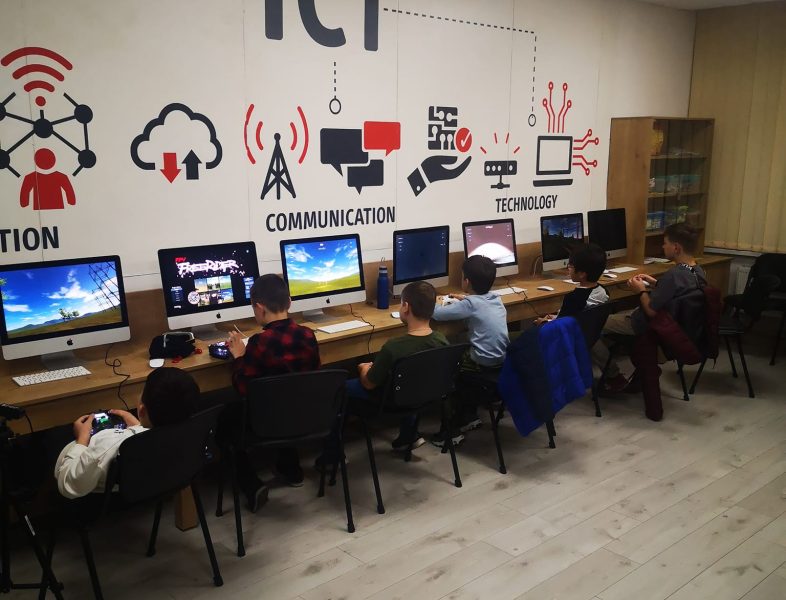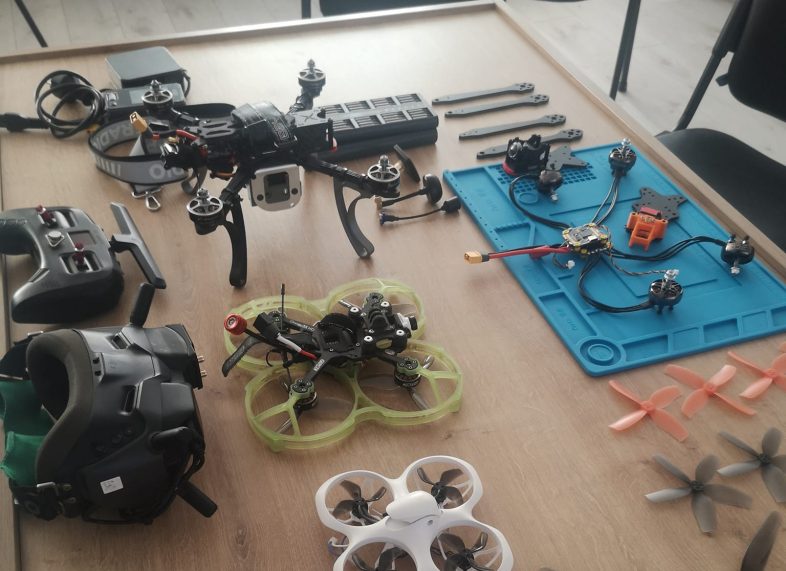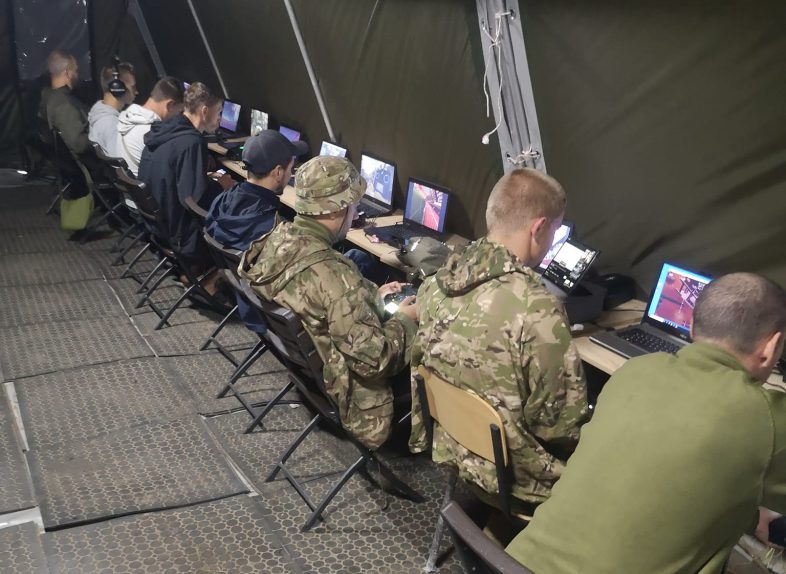The Ukrainian Week interviewed Serhiy Tkachuk, an FPV drone instructor. Prior to the full-scale Russian invasion in February 2022, he had no prior experience operating drones and was unfamiliar with simulators. However, a few weeks after the tragic news of his brother’s death on the front line, he managed to master his drone-flying skills. Now, Serhiy instructs military personnel.
In his interview with The Ukrainian Week, Serhiy shared his personal journey of mastering drones, the specific training methods he employs, the importance of drone operation skills during the ongoing war – a clash of technologies, and the role of drones on the front lines.
“If 20-27-year-old men had started learning how to operate drones 5-7 years ago, most military personnel would now know how to fly”
On the seventh day of the full-scale war near Mariupol, my second cousin was killed. He was only 25. During reconnaissance with his comrades, they came under mortar shelling. This could have been prevented if they had used drones for reconnaissance instead of soldiers. The drones wouldn’t even have been harmed there. It would have captured the enemy’s positions, and our artillery could have responded accordingly. But when it comes to history, it’s water under the bridge, unfortunately.
The day I learned about my brother’s death was a turning point. That’s when I realised where I could be most effective. My brother once mentioned that no one in his unit knew how to operate a drone, even though they had drones by then, and these were guys up to 30 years old.
I started by learning how to operate drones myself. Later, I taught my eight-year-old daughter. It turned out to be quite easy for me, actually. I have a background in teaching music, specifically trumpet, for 15 years. When I first downloaded the simulator and attempted to control the drone that way, I realised it was akin to mastering another musical instrument.
Essentially, I adapted the teaching techniques used in learning a musical instrument to the drone. It requires the same coordination of multiple actions, syncing the brain, eyes, and fingers.

Photo: Facebook | WineCorkArtMadeinUkraine
In September 2022, I launched the Free Sky Ukraine drone school for kids. Initially, I struck a deal with the principal of a school in the capital. Now, I’m already running classes in two secondary schools in Kyiv. I essentially set up the children’s drone school on a music teacher’s salary. I installed simulators in the computer labs and bought controllers and all the necessary gear for teaching. I work with kids once a week for an hour. That amounts to about four hours of teaching per month. This is ample time for a child to learn to fly, even a six-year-old. I’ve had such a student. For example, this May, we’re gearing up for a competition between two schools.
My aim is to demonstrate that these courses can be introduced in all schools across Ukraine. However, bureaucracy is currently a barrier to this goal. Not everyone comprehends the significance of children acquiring these skills during such a tumultuous time for the country.
If guys aged 20-27 had begun learning how to operate drones 5-7 years ago, the majority of our military personnel would be proficient pilots by now. If we had implemented such training in 10-11 grades and technical schools nationwide, then 30-40% of our young people would already possess the skills to operate drones.
Transitioning from teaching children to instructing a broader range, I maintained focus throughout the year. Subsequently, I reached out to Maria Berlinska, the head of the Victory Drones project. In June 2023, I received an invitation to train military personnel. Since then, I have held the position of senior instructor for the initial phase at one of the training centers. My responsibilities include teaching the fundamentals of drone operation using simulators, delivering theoretical lessons, and preparing soldiers for the second stage – hands-on flights with actual drones. I’ve had the opportunity to work with over two thousand military personnel. Each week, we welcome streams of 100-200 individuals for training. Joining the training centre during its sixth stream, we have now graduated on the 22nd.
Learning to operate a drone is within reach for anyone – but all boils down to one’s determination
Learning to operate a drone is achievable through the use of a simulator. This method allows you to grasp about 90% of the functionalities you’d find on an actual drone. The key benefit of simulators lies in their ability to train muscle memory, syncing the actions of your eyes, fingers, and brain. There is a diverse range of simulators available, with popular options including Freerider, DCL, Liftoff, and Uncrashed.
Furthermore, a systematic approach is essential. Much like learning music, no one is expected to play a complex piece right from the start. We begin by learning the notes and gradually piece them together into a musical composition. Similarly, in the simulator, it’s best to start with the simplest mode designed for beginners. This advice is particularly beneficial for those with slower reaction times. Over time, you can progress to more challenging modes. Otherwise, there’s a risk of becoming disheartened and losing faith in your abilities. Our minds work in this way: “Drones aren’t for me; I can’t do it.” Yet, everyone has the potential to succeed. The main ingredient? A strong desire.”

Photo: Facebook | WineCorkArtMadeinUkraine
It’s crucial for students to apply personalised learning methodologies. These are exercises tailored specifically to them to develop particular skills. However, it’s important not to overwhelm oneself. Hours of continuous learning don’t always produce effective results. Taking short breaks is the way to go. For instance, fly for 20 minutes, then take a break and resume practice. Start with the exercises that challenge you the most. For example, turning in different directions based on whether you’re left-handed or right-handed. It’s akin to chess: to learn the game, play against someone who is significantly better than you.
Simultaneously, learning to fly a drone independently can be done with minimal financial investment. Simply download any simulator and start practising. Some offer free demo versions, such as Freerider. To start off without spending money on a controller, you can control the drone using your touchscreen smartphone. By the way, that’s exactly how I learned to fly. I didn’t get my first controller and drone until May 2022.
I often hear that flying a drone is easier than using a simulator. Of course, it’s easier to fly drones after practising on simulators. You apply the skills you’ve acquired, even without realising it. I know examples of people who don’t believe in the effectiveness of simulators, buy drones for several thousand pounds, and end up crashing them.
A vivid proof of the simulator’s effectiveness is the film based on real events, “Gran Turismo.” It’s a movie about how gamers, transitioning to real cars, won real, not just virtual races.
From my personal experience, I can attest that individuals who were once avid gamers, particularly fans of strategy video games like World of Tanks, tend to pick up drone piloting skills more swiftly. These enthusiasts can be found stationed in drone control centres while plump generals loom over them, supposedly overseeing operations. In reality, they are quite clueless. I’ve witnessed this firsthand. The issue lies in the fact that our higher-ups are largely technologically outdated, prioritising seniority over proficiency. Their mindset was forged 30-40 years ago, heavily influenced by the Soviet era. Regrettably, they continue to dwell in the past, neglecting the future, which unquestionably belongs to technology.
Among my students, the youngest is six years old, and the oldest is 55. The challenge arises with older individuals, as the learning curve tends to be steeper for them. Thus, it’s preferable to begin cultivating these skills during adolescence. It might sound ambitious, but if at least 30-40% of Ukrainians can operate drones proficiently, we will undoubtedly be more esteemed and feared on the global stage.
Because the current conflict is essentially a clash of technologies. A single drone can make a significant impact. For instance, a £500 drone armed with standard ammunition can effortlessly disable a tank worth millions of dollars.

Photo: Facebook | WineCorkArtMadeinUkraine
When I began training the military personnel, they were soldiers who either had no prior drone piloting experience or possessed only basic skills. This training was urgent. Now, those who already have drone flying knowledge are attending our sessions. Furthermore, we have individuals joining us who my former students taught. They started from scratch and then passed on the fundamentals of drone piloting to their comrades.
Hence, our current focus is on skill enhancement. While many combat pilots excel in flying in open spaces, there are challenges with precise control. This involves the ability to manoeuvre into the smallest openings in bunkers or navigate through branches. They dedicate a month to mastering these skills.
I keep in touch with all the military personnel I’ve trained, which amounts to more than two thousand individuals. We stay connected through messages, and occasionally, I provide them with advice.
There have been instances where I’ve assisted in crucial moments. Once, a soldier phoned me in the dead of night, and I could hear gunfire in the background. He lamented that his drone wouldn’t power up, swiftly briefed me on the situation, and together, we managed to get it running. This wasn’t an isolated incident. However, the most distressing part is that approximately 40% of the soldiers I’ve trained have either perished, are in captivity, or are officially listed as missing in action.
Drones, like bullets, are disposable materials on the frontline
A drone operates much like a construction kit, where you attach all the necessary components and send it soaring into the sky to execute its designated task. Retrieving the drone can be challenging due to the multitude of EW (Electronic Warfare) systems that disrupt its signals. According to statistics, out of every ten drones, only one reaches its intended target. This is why drones, like bullets, are expendable resources on the front lines, necessitating their presence in the thousands.
The perpetual demand for drones is intertwined with the ongoing efforts to raise funds for them. Take, for instance, Victory Drones’ intriguing initiative known as “People’s FPV,” where anyone can assemble a drone at home. While it may not be perfectly calibrated initially, requiring potential tweaks and adjustments, these are minor issues that can be resolved. The crucial aspect is that individuals purchase the components with their own funds and take on the primary task of assembling the drone. The downside to this arrangement, however, is that some individuals are capitalising on the situation. If you were to order parts in bulk from China, the cost of a drone would amount to 8-9 thousand hryvnias. Yet, within our borders, the same drones are being sold for 15-20 thousand hryvnias (approx. $386-500). Essentially, some are simply profiteering from the ongoing conflict.

